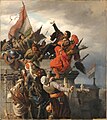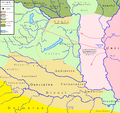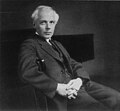Portal:Hungary
The Hungary Portal




Hungaryis alandlocked countryinCentral Europe.Spanning 93,030 square kilometres (35,920 sq mi) of theCarpathian Basin,it is bordered bySlovakiato the north,Ukraineto the northeast,Romaniato the east and southeast,Serbiato the south,CroatiaandSloveniato the southwest, andAustriato the west. Hungary has a population of 9.5 million, mostly ethnicHungariansand a significantRomani minority.Hungarian,a language belonging to theUgricbranch of theUraliclanguage family, is theofficial language,andBudapestis the country's capital andlargest city.
Prior to the foundation of the Hungarian state, various peoples settled in the territory of present-day Hungary, most notably theCelts,Romans,Huns,Germanic peoples,AvarsandSlavs.ThePrincipality of Hungarywas established in the late 9th century byÁlmosand his sonÁrpádthrough theconquest of the Carpathian Basin.KingStephen Iascended the throne in 1000, converting his realm to aChristian kingdom.The medievalKingdom of Hungarywas a European power, reachingits height in the 14th–15th centuries.After a long period ofOttoman wars,Hungary's forces were defeated at theBattle of Mohácsand its capital wascapturedin 1541, opening roughly a 150 years long period when the country was divided into three parts:Royal Hungaryloyal to theHabsburgs,Ottoman Hungaryand the largely independentPrincipality of Transylvania.The reunited Hungary came under Habsburg rule at the turn of the 18th century, fighting awar of independencein 1703–1711, and awar of independencein 1848–1849 until acompromiseallowed the formation of theAustro-Hungarian Monarchyin 1867, amajor powerinto the early 20th century. Austria-Hungary collapsed afterWorld War I,and the subsequentTreaty of Trianonin 1920 established Hungary's current borders, resulting in the loss of 71% of its historical territory, 58% of its population, and32% of its ethnic Hungarians.
In theinterwar period,after initial turmoil,Miklós Horthyascended as a determining politician,representing the monarchy as regentin place of the Habsburgs. Hungary joined theAxis powersinWorld War II,suffering significant damage and casualties. As a result, theHungarian People's Republicwas established as asatellite stateof theSoviet Union.Following the failed1956 revolution,Hungary becamecomparatively freer,but still remained a repressed member of theEastern Bloc.In 1989, concurrently with theRevolutions of 1989,Hungary peacefully transitioned into ademocraticparliamentary republic,joining theEuropean Unionin 2004 and being part of theSchengen Areasince 2007.
Hungary is ahigh-income economywithuniversal health careand tuition-freesecondary education.Hungary has a long history of significant contributions toarts,music,literature,sports,science and technology.It is apopulartourist destinationin Europe, drawing 24.5 million international tourists in 2019. It is a member of numerous international organisations, including theCouncil of Europe,NATO,United Nations,World Health Organization,World Trade Organization,World Bank,Asian Infrastructure Investment Bank,and theVisegrád Group.(Full article...)
TurkorTurksmay refer to: (Full article...)
Selected article -
Hungarians,also known asMagyars(/ˈmæɡjɑːrz/MAG-yarz;Hungarian:magyarok[ˈmɒɟɒrok]), are aCentral Europeannationand anethnic groupnative toHungary(Hungarian:Magyarország) and historical Hungarian lands (i.e. belonging to the formerKingdom of Hungary) who share a commonculture,history,ancestry,andlanguage.The Hungarian language belongs to theUralic language family,alongside, most notablyFinnishandEstonian.
There are an estimated 14.5 million ethnic Hungarians and their descendants worldwide, of whom 9.6 million live in today's Hungary. About 2 million Hungarians live in areas that were part of the Kingdom of Hungary before theTreaty of Trianonin 1920 and are now parts of Hungary's seven neighbouring countries,Slovakia,Ukraine,Romania,Serbia,Croatia,Slovenia,andAustria.In addition, significant groups of people with Hungarian ancestry live in various other parts of the world, most of them in theUnited States,Canada,Germany,France,theUnited Kingdom,Chile,Brazil,Australia,andArgentina,and therefore constitute theHungarian diaspora(Hungarian:magyar diaszpóra). (Full article...)People
- Musicians
Béla Bartók– János Bihari– Ernő Dohnányi– Béni Egressy– Ferenc Erkel– Zoltán Kocsis– Zoltán Kodály– Franz Liszt- Eugene Ormandy- George Szell- András Schiff
- Painters
Gyula Benczúr– Tivadar Csontváry Kosztka– Béla Czóbel– Árpád Feszty– Károly Lotz– Viktor Madarász– Mihály Munkácsy– József Rippl-Rónai– Pál Szinyei Merse– István Szőnyi– Victor Vasarely
- Photographers
Brassaï– Cornell Capa– Robert Capa– Lucien Hervé– André Kertész– László Moholy-Nagy– Martin Munkácsi
- Scientists
Béla H. Bánáthy– Zoltán Bay– Georg von Békésy– Farkas Bolyai– János Bolyai– Károly Bund– József Eötvös– Loránd Eötvös– Dennis Gabor– John Charles Harsanyi– George de Hevesy– Alexander Csoma de Kőrös– László Lovász– John von Neumann– George Andrew Olah– Ernő Rubik– Hans Selye– Ignaz Semmelweis– Charles Simonyi– János Szentágothai– Albert Szent-Györgyi– Leó Szilárd– Edward Teller– Eugene Wigner
- Writers and poets
Endre Ady– János Arany– József Eötvös– György Faludy– Béla Hamvas– Mór Jókai– Attila József– Ferenc Kazinczy– Imre Kertész– János Kodolányi– Ferenc Kölcsey– Imre Madách– Sándor Márai– Ferenc Molnár– Sándor Petőfi– Miklós Radnóti– Magda Szabó– Antal Szerb– Miklós Vámos– Mihály Vörösmarty
- Statesmen, Politicians and Military
Gyula Andrássy– Lajos Batthyány– Gabriel Bethlen– Stephen Bocskay– Matthias Corvinus– Ferenc Deák– Miklós Horthy– Lajos Kossuth– Ferenc Nagy– Imre Nagy– Bertalan Szemere– István Széchenyi– Miklós Wesselényi– Vilmos Nagy of Nagybaczon
- Sportspeople
József Bozsik– Krisztina Egerszegi– Zoltán Gera– Dezső Gyarmati– Ágnes Keleti– Péter Lékó– Csaba Mérő– Tibor Nyilasi– László Papp– Judit Polgár– Zsuzsa Polgár– Ferenc Puskás
- Film & Stage
Nimród Antal– Michael Curtiz– John Garfield– Miklós Jancsó– Sir Alexander Korda– Peter Lorre– Béla Lugosi– Emeric Pressburger– Miklós Rózsa– Andy G. Vajna– Gábor Zsazsa
Emeric,also known asHenryorImre(Hungarian:Imre,Croatian:Emerik,Slovak:Imrich;1174 – 30 November 1204), wasKing of HungaryandCroatiabetween 1196 and 1204. In 1184, his father,Béla III of Hungary,ordered that he be crowned king, and appointed him as ruler ofCroatiaandDalmatiaaround 1195. Emeric ascended the throne after the death of his father. During the first four years of his reign, hefoughthis rebellious brother,Andrew,who forced Emeric to make him ruler of Croatia and Dalmatia asappanage.
Emeric cooperated with theHoly Seeagainst theBosnian Church,which theCatholic Churchconsidered to beheretical.Taking advantage of a civil war, Emeric expanded hissuzeraintyoverSerbia.He failed to prevent theRepublic of Venice,which was assisted by crusaders of theFourth Crusade,from seizingZadarin 1202. He also could not impede the rise ofBulgariaalong the southern frontiers of his kingdom. Emeric was the first Hungarian monarch to use the "Árpád stripes"as his personal coat of arms and to adopt the title ofKing of Serbia.Before his death, Emeric had his four-year-old son,Ladislaus III,crowned king. (Full article...)Selected picture
Wikiprojects
Related projects:
Related portals
Things you can do
| The followingstubarticles would benefit from expansion. | |
General images -
The following are images from various Hungary-related articles on Wikipedia.
Topics
Categories
New articles
Rules|Match log|Results page(for watching) | Last updated: 2024-07-18 20:52 (UTC)
Note:The list display can now be customized by each user. SeeList display personalizationfor details.
- Saskia Broedelet(edit|talk|history|links|watch|logs|tools)byRiley1012(talk·contribs·new pages (16)) started on 2024-07-18, score: 20
- Stephen Pacsai(edit|talk|history|links|watch|logs|tools)byNorden1990(talk·contribs·new pages (11)) started on 2024-07-18, score: 130
- Anastasiia Antoniak(edit|talk|history|links|watch|logs|tools)byІлля Криворучко(talk·contribs·new pages (2)) started on 2024-07-18, score: 20
- 2024 Hungarian Grand Prix(edit|talk|history|links|watch|logs|tools)byCerebral726(talk·contribs·new pages (3)) started on 2024-07-18, score: 60
- Siege of Užice(edit|talk|history|links|watch|logs|tools)byعبدالرحمن4132(talk·contribs·new pages (14)) started on 2024-07-18, score: 20
- Battle of Bicske(edit|talk|history|links|watch|logs|tools)byعبدالرحمن4132(talk·contribs·new pages (14)) started on 2024-07-18, score: 130
- Battle of Győr (1577)(edit|talk|history|links|watch|logs|tools)byعبدالرحمن4132(talk·contribs·new pages (14)) started on 2024-07-18, score: 110
- Kai Trump(edit|talk|history|links|watch|logs|tools)byMAL MALDIVE(talk·contribs·new pages (10)) started on 2024-07-18, score: 20
- Róbert Pap(edit|talk|history|links|watch|logs|tools)byNorden1990(talk·contribs·new pages (11)) started on 2024-07-17, score: 160
- Berthold Feiwel(edit|talk|history|links|watch|logs|tools)byDag21902190(talk·contribs·new pages (21)) started on 2024-07-17, score: 40
- Péter Lévai(edit|talk|history|links|watch|logs|tools)byGeorge Yul(talk·contribs·new pages (1)) started on 2024-07-17, score: 80
- Panna Bartha(edit|talk|history|links|watch|logs|tools)byVecihi91(talk·contribs·new pages (5)) started on 2024-07-17, score: 80
- Mattoni 1873(edit|talk|history|links|watch|logs|tools)byRevirvlkodlaku(talk·contribs·new pages (3)) started on 2024-07-17, score: 40
- Termination of the German and Austro-Hungarian Legations(edit|talk|history|links|watch|logs|tools)byThyRaiseTempo(talk·contribs·new pages (1)) started on 2024-07-17, score: 20
- 2024–25 Women's EHF European League(edit|talk|history|links|watch|logs|tools)byILoveSport2006(talk·contribs·new pages (10)) started on 2024-07-16, score: 30
- Carson Coma(edit|talk|history|links|watch|logs|tools)byTungstenTime(talk·contribs·new pages (2)) started on 2024-07-13, score: 80
- Water polo at the 2024 Summer Olympics – Women's team rosters(edit|talk|history|links|watch|logs|tools)byKante4(talk·contribs·new pages (9)) started on 2024-07-12, score: 20
- 2024–25 EHF European League(edit|talk|history|links|watch|logs|tools)byILoveSport2006(talk·contribs·new pages (10)) started on 2024-07-16, score: 40
- 2024–25 Fehérvár FC season(edit|talk|history|links|watch|logs|tools)byCakesam(talk·contribs·new pages (5)) started on 2024-07-16, score: 140
- Dmytro Lovchynskyi(edit|talk|history|links|watch|logs|tools)byOberhof(talk·contribs·new pages (15)) started on 2024-07-16, score: 20
- 1949 AAA Championships(edit|talk|history|links|watch|logs|tools)byApricotFoot(talk·contribs·new pages (90)) started on 2024-07-16, score: 20
- Safiye Sultan (Haseki of Murad III)(edit|talk|history|links|watch|logs|tools)by103.113.149.199(talk·contribs·new pages (4)) started on 2024-07-16, score: 30
- 2005–06 Kaposvári Rákóczi FC season(edit|talk|history|links|watch|logs|tools)byRakeck(talk·contribs·new pages (15)) started on 2024-07-16, score: 250
- Zhu Yuanling(edit|talk|history|links|watch|logs|tools)byToadboy123(talk·contribs·new pages (6)) started on 2024-07-16, score: 20
- Heorhii Chyzhevskyi(edit|talk|history|links|watch|logs|tools)byІлля Криворучко(talk·contribs·new pages (2)) started on 2024-07-16, score: 20
- Milo's Tea Company(edit|talk|history|links|watch|logs|tools)byDarkNight0917(talk·contribs·new pages (19)) started on 2024-07-15, score: 20
- Garai noble family(edit|talk|history|links|watch|logs|tools)bySantasa99(talk·contribs·new pages (7)) started on 2024-07-15, score: 90
- Alois Neuman(edit|talk|history|links|watch|logs|tools)byArthistorian1977(talk·contribs·new pages (3)) started on 2024-07-15, score: 20
- 1947 AAA Championships(edit|talk|history|links|watch|logs|tools)byApricotFoot(talk·contribs·new pages (90)) started on 2024-07-15, score: 30
- Jan-Peter Warnke(edit|talk|history|links|watch|logs|tools)byMoondragon21(talk·contribs·new pages (125)) started on 2024-07-15, score: 20
- Problems and Theorems in Analysis(edit|talk|history|links|watch|logs|tools)byTenpop421(talk·contribs·new pages (12)) started on 2024-07-15, score: 30
- Elizabet Inneh(edit|talk|history|links|watch|logs|tools)by.karellian-24(talk·contribs·new pages (4)) started on 2024-07-14, score: 60
- Water polo at the 2024 Summer Olympics – Men's team rosters(edit|talk|history|links|watch|logs|tools)byKante4(talk·contribs·new pages (9)) started on 2024-07-12, score: 20
- 2024 FIM Women's Motorcycling World Championship(edit|talk|history|links|watch|logs|tools)byJohn B123(talk·contribs·new pages (6)) started on 2024-07-14, score: 20
- Pálosvörösmart(edit|talk|history|links|watch|logs|tools)byMarvanyember(talk·contribs·new pages (1)) started on 2024-07-14, score: 40
- 2024 Budapest Grand Prix – Doubles(edit|talk|history|links|watch|logs|tools)byYimingbao(talk·contribs·new pages (23)) started on 2024-07-14, score: 20
- 2024–25 Magyar Kupa(edit|talk|history|links|watch|logs|tools)byCakesam(talk·contribs·new pages (5)) started on 2024-07-14, score: 370
- Battle of Jarosław (1245)(edit|talk|history|links|watch|logs|tools)bySetergh(talk·contribs·new pages (5)) started on 2024-07-14, score: 40
- 1996–97 in Australian soccer(edit|talk|history|links|watch|logs|tools)byFastCube(talk·contribs·new pages (14)) started on 2024-07-14, score: 30
- Church of Saint Sava, Čerević(edit|talk|history|links|watch|logs|tools)byMirkoS18(talk·contribs·new pages (19)) started on 2024-07-14, score: 20
- Hungarus Consciousness(edit|talk|history|links|watch|logs|tools)byMousieplousie(talk·contribs·new pages (1)) started on 2024-07-14, score: 50
- All Is Dust(edit|talk|history|links|watch|logs|tools)bySirZPthundergod9001(talk·contribs·new pages (6)) started on 2024-07-14, score: 20
- Martin Kern(edit|talk|history|links|watch|logs|tools)byGeneralissima(talk·contribs·new pages (40)) started on 2024-07-13, score: 20
- Bejc (genus)(edit|talk|history|links|watch|logs|tools)byNorden1990(talk·contribs·new pages (11)) started on 2024-07-13, score: 90
- 2024 European Modern Pentathlon Championships(edit|talk|history|links|watch|logs|tools)byBearas(talk·contribs·new pages (1)) started on 2024-07-13, score: 60
- 1937 AAA Championships(edit|talk|history|links|watch|logs|tools)byApricotFoot(talk·contribs·new pages (90)) started on 2024-07-13, score: 30
- 1935 AAA Championships(edit|talk|history|links|watch|logs|tools)byApricotFoot(talk·contribs·new pages (90)) started on 2024-07-13, score: 20
- 1934 AAA Championships(edit|talk|history|links|watch|logs|tools)byApricotFoot(talk·contribs·new pages (90)) started on 2024-07-13, score: 20
- Chinese cruiser Number 68(edit|talk|history|links|watch|logs|tools)bySemi-Lobster(talk·contribs·new pages (7)) started on 2024-07-13, score: 40
- Paul Tibold(edit|talk|history|links|watch|logs|tools)byNorden1990(talk·contribs·new pages (11)) started on 2024-07-13, score: 100
- 1926 AAA Championships(edit|talk|history|links|watch|logs|tools)byApricotFoot(talk·contribs·new pages (90)) started on 2024-07-13, score: 20
- Felix Svensson(edit|talk|history|links|watch|logs|tools)bySeacactus 13(talk·contribs·new pages (35)) started on 2024-07-13, score: 20
- Partium Christian University(edit|talk|history|links|watch|logs|tools)byBirdybike(talk·contribs·new pages (1)) started on 2024-07-13, score: 20
- Biosynthesis of a Biotin Compound Containing ⁷⁵Se(edit|talk|history|links|watch|logs|tools)byJoeK2033(talk·contribs·new pages (16)) started on 2024-07-05, score: 20
- Bulgaria at the World Artistic Gymnastics Championships(edit|talk|history|links|watch|logs|tools)byMypurplelightsaber(talk·contribs·new pages (14)) started on 2024-07-12, score: 20
- 2024 Budapest Grand Prix – Singles(edit|talk|history|links|watch|logs|tools)byYimingbao(talk·contribs·new pages (23)) started on 2024-07-12, score: 20
- Matej Cvetanoski(edit|talk|history|links|watch|logs|tools)byBakir123(talk·contribs·new pages (1)) started on 2024-07-12, score: 50
- Francesca Allen(edit|talk|history|links|watch|logs|tools)bySarahTHunter(talk·contribs·new pages (29)) started on 2024-07-12, score: 20
- Felix Albrecht Harta(edit|talk|history|links|watch|logs|tools)byCerebellum(talk·contribs·new pages (58)) started on 2024-07-12, score: 40
- Battle of the San river (1914)(edit|talk|history|links|watch|logs|tools)byDushnilkin(talk·contribs·new pages (3)) started on 2024-07-12, score: 40
- 2014 FC BATE Borisov season(edit|talk|history|links|watch|logs|tools)byRakeck(talk·contribs·new pages (15)) started on 2024-07-12, score: 20
- Zheng Haohao(edit|talk|history|links|watch|logs|tools)byToadboy123(talk·contribs·new pages (6)) started on 2024-07-12, score: 20
- NATO Security Assistance and Training for Ukraine(edit|talk|history|links|watch|logs|tools)bySearch'n'write(talk·contribs·new pages (2)) started on 2024-07-12, score: 20
- 2025 Euroformula Open Championship(edit|talk|history|links|watch|logs|tools)byHmnphl(talk·contribs·new pages (2)) started on 2024-07-11, score: 30
- 2025 International GT Open(edit|talk|history|links|watch|logs|tools)byMaceekim(talk·contribs·new pages (6)) started on 2024-07-11, score: 30
- Homogeneity (semantics)(edit|talk|history|links|watch|logs|tools)byBotterweg14(talk·contribs·new pages (3)) started on 2024-07-11, score: 20
- Stefano Ballarini(edit|talk|history|links|watch|logs|tools)by4meter4(talk·contribs·new pages (54)) started on 2024-07-10, score: 60
- 2024 visits by Viktor Orbán to Russia and China(edit|talk|history|links|watch|logs|tools)byNoble Attempt(talk·contribs·new pages (15)) started on 2024-07-08, score: 60
- 1914 AAA Championships(edit|talk|history|links|watch|logs|tools)byApricotFoot(talk·contribs·new pages (90)) started on 2024-07-11, score: 20
- Alfred Hitchcock Presents season 2(edit|talk|history|links|watch|logs|tools)bySink Cat(talk·contribs·new pages (6)) started on 2024-07-11, score: 20
- NATO Washington Summit Declaration(edit|talk|history|links|watch|logs|tools)byNoble Attempt(talk·contribs·new pages (15)) started on 2024-07-10, score: 20
- Synnøve Berg(edit|talk|history|links|watch|logs|tools)byOceanh(talk·contribs·new pages (15)) started on 2024-07-10, score: 20
- Europe of Sovereign Nations(edit|talk|history|links|watch|logs|tools)byDerEchteJoan(talk·contribs·new pages (1)) started on 2024-07-10, score: 30
- Chetfalva(edit|talk|history|links|watch|logs|tools)byTarMilán(talk·contribs·new pages (1)) started on 2024-07-10, score: 60
- Vladyslav Fisun(edit|talk|history|links|watch|logs|tools)byCatgirl(talk·contribs·new pages (2)) started on 2024-07-10, score: 20
- 2024 Hungarian Presidency of the Council of the European Union(edit|talk|history|links|watch|logs|tools)byNoble Attempt(talk·contribs·new pages (15)) started on 2024-07-10, score: 40
- Athletics at the 2024 Summer Olympics – Mixed 4 × 400 metres relay(edit|talk|history|links|watch|logs|tools)byJennypedia(talk·contribs·new pages (23)) started on 2024-07-09, score: 20
- Maria Radna Monastery(edit|talk|history|links|watch|logs|tools)byJeyReydar97(talk·contribs·new pages (22)) started on 2024-07-09, score: 50
- Olšavský(edit|talk|history|links|watch|logs|tools)byAltenmann(talk·contribs·new pages (110)) started on 2024-07-09, score: 20
- William Yang (swimmer)(edit|talk|history|links|watch|logs|tools)byBeanieFan11(talk·contribs·new pages (95)) started on 2024-07-09, score: 20
- Kościuszko at Racławice(edit|talk|history|links|watch|logs|tools)byAsilvering(talk·contribs·new pages (6)) started on 2024-07-09, score: 20
- Eduard Elbogen(edit|talk|history|links|watch|logs|tools)byVirtualiter(talk·contribs·new pages (2)) started on 2024-07-09, score: 20
- A. Molnár Ferenc(edit|talk|history|links|watch|logs|tools)byArnennier(talk·contribs·new pages (1)) started on 2024-07-09, score: 100
- Sikh Park(edit|talk|history|links|watch|logs|tools)byMaplesyrupSushi(talk·contribs·new pages (15)) started on 2024-07-09, score: 20
- BYD Electronic(edit|talk|history|links|watch|logs|tools)by2804:389:811F:B5F2:4A3:BEFF:FEDF:E8FA(talk·contribs·new pages (1)) started on 2024-07-09, score: 40
- 2024–25 EuroCup Women(edit|talk|history|links|watch|logs|tools)byILoveSport2006(talk·contribs·new pages (10)) started on 2024-07-09, score: 30
- Shams Aghahuseynova(edit|talk|history|links|watch|logs|tools)byManiakilljoy97(talk·contribs·new pages (7)) started on 2024-07-09, score: 20
- Dutch East Indies at the FIFA World Cup(edit|talk|history|links|watch|logs|tools)byBabiBandung(talk·contribs·new pages (1)) started on 2024-07-09, score: 30
- FC Dinamo Tbilisi in European football(edit|talk|history|links|watch|logs|tools)byKlio654(talk·contribs·new pages (4)) started on 2024-07-09, score: 20
- Battle of Körmend(edit|talk|history|links|watch|logs|tools)bySkibidi36(talk·contribs·new pages (1)) started on 2024-07-09, score: 20
- Swimming at the 2024 European Aquatics Championships – Men's 4 × 100 metre medley relay(edit|talk|history|links|watch|logs|tools)byCakesam(talk·contribs·new pages (5)) started on 2024-07-09, score: 20
- List of armed conflicts between Bosnia and Serbia(edit|talk|history|links|watch|logs|tools)byAsilvering(talk·contribs·new pages (6)) started on 2024-07-08, score: 20
- People's Stadium (disambiguation)(edit|talk|history|links|watch|logs|tools)byParadygmaty(talk·contribs·new pages (3)) started on 2024-07-08, score: 20
- Madar (surname)(edit|talk|history|links|watch|logs|tools)byAltenmann(talk·contribs·new pages (110)) started on 2024-07-08, score: 20
- Veronika Madár(edit|talk|history|links|watch|logs|tools)byAltenmann(talk·contribs·new pages (110)) started on 2024-07-08, score: 50
- Lorenzo Minh Casali(edit|talk|history|links|watch|logs|tools)byMypurplelightsaber(talk·contribs·new pages (14)) started on 2024-07-08, score: 20
- Eugen Wratislaw of Mitrovice(edit|talk|history|links|watch|logs|tools)byFromCzech(talk·contribs·new pages (10)) started on 2024-07-08, score: 30
- 2024 peace missions by Viktor Orbán(edit|talk|history|links|watch|logs|tools)byNoble Attempt(talk·contribs·new pages (15)) started on 2024-07-08, score: 50
- 1993–94 in Australian soccer(edit|talk|history|links|watch|logs|tools)byFastCube(talk·contribs·new pages (14)) started on 2024-07-08, score: 20
- MTB-82(edit|talk|history|links|watch|logs|tools)byCerebellum(talk·contribs·new pages (58)) started on 2024-07-07, score: 20
- Ante Tresić Pavičić(edit|talk|history|links|watch|logs|tools)byTomobe03(talk·contribs·new pages (5)) started on 2024-07-07, score: 20
- Inger Kavlie(edit|talk|history|links|watch|logs|tools)byOceanh(talk·contribs·new pages (15)) started on 2024-07-07, score: 20
- Hungarian Boy Monument(edit|talk|history|links|watch|logs|tools)byArtemis Andromeda(talk·contribs·new pages (22)) started on 2024-07-07, score: 60
- Telemedia InteracTV(edit|talk|history|links|watch|logs|tools)byKoiraniemi(talk·contribs·new pages (1)) started on 2024-07-07, score: 40
- Săpânța-Peri Monastery(edit|talk|history|links|watch|logs|tools)byJeyReydar97(talk·contribs·new pages (22)) started on 2024-07-07, score: 20
- Thea Helseth(edit|talk|history|links|watch|logs|tools)byOceanh(talk·contribs·new pages (15)) started on 2024-07-07, score: 20
- Ivo Grisogono(edit|talk|history|links|watch|logs|tools)byTomobe03(talk·contribs·new pages (5)) started on 2024-07-07, score: 20
- Tibold (genus)(edit|talk|history|links|watch|logs|tools)byNorden1990(talk·contribs·new pages (11)) started on 2024-07-07, score: 80
- Imre Katzenbach(edit|talk|history|links|watch|logs|tools)byDas osmnezz(talk·contribs·new pages (76)) started on 2024-07-07, score: 100
- Austrian Federal Railways(edit|talk|history|links|watch|logs|tools)byJackdude101(talk·contribs·new pages (5)) started on 2024-07-07, score: 20
- List of rider deaths in motorcycle racing(edit|talk|history|links|watch|logs|tools)byMike Selinker(talk·contribs·new pages (5)) started on 2024-07-07, score: 30
- Prvislav Grisogono(edit|talk|history|links|watch|logs|tools)byTomobe03(talk·contribs·new pages (5)) started on 2024-07-06, score: 20
- 2024–25 Ferencvárosi TC season(edit|talk|history|links|watch|logs|tools)byCakesam(talk·contribs·new pages (5)) started on 2024-07-06, score: 130
- Deaths in June 2024(edit|talk|history|links|watch|logs|tools)byRusted AutoParts(talk·contribs·new pages (3)) started on 2024-07-06, score: 30
- Harka (disambiguation)(edit|talk|history|links|watch|logs|tools)byError(talk·contribs·new pages (6)) started on 2024-07-06, score: 80
- Snagov Declaration(edit|talk|history|links|watch|logs|tools)bySuper Dromaeosaurus(talk·contribs·new pages (7)) started on 2024-07-06, score: 40
- Tatiana Grigorovici(edit|talk|history|links|watch|logs|tools)byDsp13(talk·contribs·new pages (20)) started on 2024-07-06, score: 20
- 2024–25 Nemzeti Bajnokság I(edit|talk|history|links|watch|logs|tools)byRakeck(talk·contribs·new pages (15)) started on 2024-07-06, score: 290
- Stjepan Srkulj(edit|talk|history|links|watch|logs|tools)byTomobe03(talk·contribs·new pages (5)) started on 2024-07-05, score: 20
- Football at the 1956 Summer Olympics – Men's European Qualifiers(edit|talk|history|links|watch|logs|tools)byAleksandr Grigoryev(talk·contribs·new pages (13)) started on 2024-07-05, score: 20
- Theobald (ispán)(edit|talk|history|links|watch|logs|tools)byNorden1990(talk·contribs·new pages (11)) started on 2024-07-05, score: 120
- Football at the 1960 Summer Olympics – Men's European Qualifiers(edit|talk|history|links|watch|logs|tools)byAleksandr Grigoryev(talk·contribs·new pages (13)) started on 2024-07-05, score: 40
- Anna of Brunswick(edit|talk|history|links|watch|logs|tools)byGobonobo(talk·contribs·new pages (212)) started on 2024-07-05, score: 20
- Vilim Bukšeg(edit|talk|history|links|watch|logs|tools)byTomobe03(talk·contribs·new pages (5)) started on 2024-07-05, score: 20
- Delhi Chamber Choir(edit|talk|history|links|watch|logs|tools)byPichemist(talk·contribs·new pages (4)) started on 2024-07-04, score: 20
- 2024–25 Debreceni EAC (basketball) season(edit|talk|history|links|watch|logs|tools)byCakesam(talk·contribs·new pages (5)) started on 2024-07-04, score: 160
- 2024 British Grand Prix(edit|talk|history|links|watch|logs|tools)byDualSkream(talk·contribs·new pages (2)) started on 2024-07-04, score: 20
- Izaak of Spain(edit|talk|history|links|watch|logs|tools)byPiotrus(talk·contribs·new pages (4)) started on 2024-07-04, score: 20
- Meanings of minor planet names: 639001–640000(edit|talk|history|links|watch|logs|tools)byIlvon(talk·contribs·new pages (5)) started on 2024-07-04, score: 20
Associated Wikimedia
The followingWikimedia Foundationsister projects provide more on this subject:
-
Commons
Free media repository -
Wikibooks
Free textbooks and manuals -
Wikidata
Free knowledge base -
Wikinews
Free-content news -
Wikiquote
Collection of quotations -
Wikisource
Free-content library -
Wikiversity
Free learning tools -
Wikivoyage
Free travel guide -
Wiktionary
Dictionary and thesaurus























































































